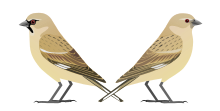Afghan snowfinch
| Afghan snowfinch | |
|---|---|

| |
| Illustration of a male (left) and a female (right) | |
| Scientific classification | |
| Domain: | Eukaryota |
| Kingdom: | Animalia |
| Phylum: | Chordata |
| Class: | Aves |
| Order: | Passeriformes |
| Family: | Passeridae |
| Genus: | Pyrgilauda |
| Species: | P. theresae
|
| Binomial name | |
| Pyrgilauda theresae (R. Meinertzhagen, 1937)
| |
| Synonyms[2] | |
| |
The Afghan snowfinch (Pyrgilauda theresae) or the Afghan ground-sparrow, bar-tailed snowfinch, Meinertzhagen's snowfinch, or Theresa's snowfinch, is a
Taxonomy and systematics
This species was first scientifically recorded relatively late, by
Meinertzhagen placed this species in the genus
Description
It is 13.5–15 centimetres (5.3–5.9 in) long, weighing 23–35 grams (0.81–1.23 oz). The wingspan ranges from 8.5 to 9.9 cm (3.3–3.9 in), and bills measure from 1.3 to 1.5 cm (0.51–0.59 in). Females are slightly smaller on average than males.[3]
The male is grey-brown with some white in the wings and a black face-mask and two-pronged patch on the throat. The female is a buff-tinged brown, with a weaker, greyer face mask and less white in the wings. There are short dark streaks on the mantle and a white subterminal band on the tail feathers other than the central pair. There is white on the upperwing coverts, secondaries, and inner primaries. The male has a brick red iris.[3][10] The plumage of juvenile birds after fledging has not been described, but can be assumed to be similar to the female's plumage.[3]
The only similar species that occur in the Afghan snowfinch's range are the white-winged snowfinch and the desert finch. It can be distinguished from the former by the smaller white patches on the wings and an overall more brownish plumage. While it is similar in general appearance to the latter species, the Afghan snowfinch is more streaked, has stronger facial markings, and has a smaller bill, among other differences.[3]
The flight of the Afghan snowfinch is heavy and straight. The alarm call is a sharp tsi, and they make soft quaak calls in flight, and a stridulant zig-zig.[10]
Distribution and habitat
The Afghan snowfinch is the only species of bird known to be endemic to Afghanistan.[11] It is found only in some northern parts of the Hindu Kush mountains, where it occurs at elevations of 2,575–3,000 m (8,450–9,840 ft). Besides the Shibar Pass, it is known from Deh Sabz and Unai Pass, and a few other localities between 67° and 69° E in the northerly ranges of the Hindu Kush. This species disperses in the winter especially after heavy snowfalls, and moves slightly beyond its breeding range, into lower altitudes and northwards into Badghis Province. It has been recorded on occasion as a vagrant in southern Turkmenistan.[1][3][12] Its habitats are stony mountain slopes, plateaux, and open hillsides in the passes.[3]
Despite having a relatively small range and population, it is not thought to have an unstable population or significant threats, so it is assessed as a species of
Behaviour and ecology
In winter, the Afghan snowfinch forms large flocks of dozens or hundreds, sometimes mixed with snowfinches of other species, rock sparrows, and various larks. This species feeds mostly on small seeds, from plants such as Carex pachystylis, Convolvulus divaricatus, and Thuspeinantha persica, and it will also eat insects such as ants and weevils.[3][7]
The Afghan snowfinch builds
References
- ^ . Retrieved 12 November 2021.
- ^ ISBN 978-84-96553-50-7.
- ^ a b c d e f g h i Clement, Harris & Davis 1993, pp. 481–482
- .
- ^ Boelens & Watkins 2003, p. 337.
- ^ Seabrook, John (29 May 2006). "Ruffled Feathers" (PDF). The New Yorker. Archived from the original (PDF) on 27 July 2014. Retrieved 8 October 2009.
- ^ .
- ^ Mlíkovský, Jirí (1998). "Generic name of southern snowfinches" (PDF). Forktail. 14: 85. Archived from the original (PDF) on 15 February 2012.
- ^ Lei, Fu-Min; Wang, Ai-Zhen; Wang, Gang; Yin, Zuo-Hua (2005). "Vocalizations of red-necked snow finch, Pyrgilauda ruficollis on the Tibetan Plateau, China – a syllable taxonomic signal?" (PDF). Folia Zoologica. 54 (1–2): 135–146. Archived from the original (PDF) on 2016-04-12. Retrieved 2014-09-02.
- ^ a b c Rasmussen & Anderton 2005, p. 578
- ISBN 9781610911580.
- .
- ^ Revkin, Andrew C. (22 April 2009). "Afghanistan: The First National Park". The New York Times. New York. p. A10. Retrieved 1 September 2014.
- ^ Busuttil, Simon; Aye, Raffael (2009). "Ornithological surveys in Bamiyan province, Islamic Republic of Afghanistan". Sandgrouse. 31 (2): 146–159.
Works cited
- Boelens, Bo; Watkins, Michael (2003). Whose Bird?: Common Bird Names and the People They Commemorate. Yale University Press. ISBN 0-300-10359-X.
- Clement, Peter; Harris, Alan; Davis, John (1993). Finches and Sparrows: an Identification Guide. Princeton, New Jersey: Princeton University Press. ISBN 0-691-03424-9.
- Rasmussen, P. C.; Anderton, J.C. (2005). Birds of South Asia: The Ripley Guide. Vol. 2. Smithsonian Institution & Lynx Edicions.
External links
- "Afghan snowfinch media". Internet Bird Collection.

